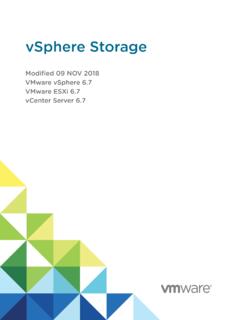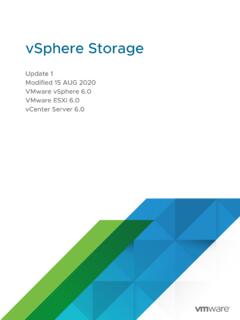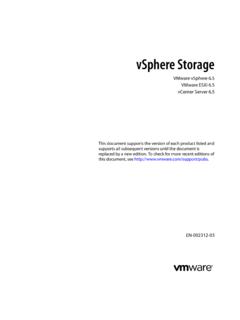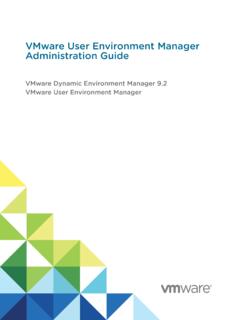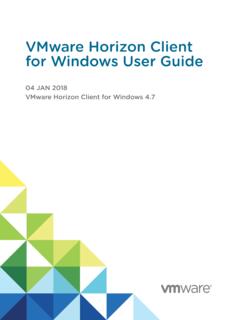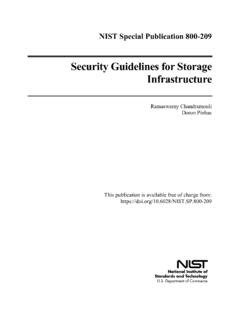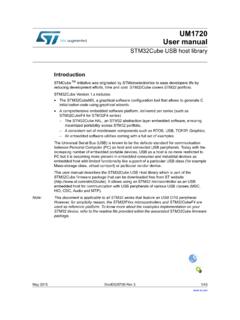Transcription of vSphere Storage - VMware vSphere 7
1 vSphere StorageUpdate 3 VMware vSphere ESXi Server can find the most up-to-date technical documentation on the VMware website at: , Hillview Alto, CA 2009-2022 VMware , Inc. All rights reserved. Copyright and trademark StorageVMware, vSphere Storage14 Updated Information151 Introduction to Storage16 Traditional Storage Virtualization Models16 Software-Defined Storage Models18vSphere Storage APIs192 Getting Started with a Traditional Storage Model20 Types of Physical Storage20 Local Storage20 Networked Storage21 Target and Device Representations 26 How Virtual Machines Access Storage26 Storage Device Characteristics27 Comparing Types of Storage30 Supported Storage Adapters31 View Storage Adapter Information32 Datastore Characteristics33 Display Datastore Information35 Using Persistent Memory36 Monitor PMem Datastore Statistics383 Overview of Using ESXi with a SAN40 ESXi and SAN Use Cases41 Specifics of Using SAN Storage with ESXi42 ESXi Hosts and Multiple Storage Arrays42 Making LUN
2 Decisions42 Use the Predictive Scheme to Make LUN Decisions43 Use the Adaptive Scheme to Make LUN Decisions43 Selecting Virtual Machine Locations44 Third-Party Management Applications45 SAN Storage Backup Considerations45 Using Third-Party Backup Packages464 Using ESXi with Fibre Channel SAN47 Fibre Channel SAN Concepts47 VMware , in Fibre Channel SAN48 Fibre Channel Storage Array Types48 Using Zoning with Fibre Channel SANs49 How Virtual Machines Access Data on a Fibre Channel SAN495 Configuring Fibre Channel Storage51 ESXi Fibre Channel SAN Requirements51 ESXi Fibre Channel SAN Restrictions51 Setting LUN Allocations52 Setting Fibre Channel HBAs52 Installation and Setup Steps53N-Port ID Virtualization53 How NPIV-Based LUN Access Works53 Requirements for Using NPIV54 NPIV Capabilities and Limitations54 Configure or Modify WWN Assignments556 Configuring Fibre Channel over Ethernet57 Fibre Channel over Ethernet Adapters57 Configuration Guidelines for Software FCoE58 Set Up Networking for Software FCoE59 Add Software FCoE Adapters607 Booting ESXi from Fibre Channel SAN62 Boot from SAN
3 Benefits62 Requirements and Considerations when Booting from Fibre Channel SAN 63 Getting Ready for Boot from SAN63 Configure SAN Components and Storage System64 Configure Storage Adapter to Boot from SAN64 Set Up Your System to Boot from Installation Media65 Configure Emulex HBA to Boot from SAN65 Enable the BootBIOS Prompt65 Enable the BIOS66 Configure QLogic HBA to Boot from SAN668 Booting ESXi with Software FCoE69 Requirements and Considerations for Software FCoE Boot69 Set Up Software FCoE Boot70 Configure Software FCoE Boot Parameters71 Install and Boot ESXi from Software FCoE LUN71 Troubleshooting Boot from Software FCoE for an ESXi Host72vSphere StorageVMware, Practices for Fibre Channel Storage73 Preventing Fibre Channel SAN Problems73 Disable Automatic ESXi Host Registration74 Optimizing Fibre Channel SAN Storage Performance74 Storage Array Performance75 Server Performance with Fibre Channel7510 Using ESXi with iSCSI SAN77 About iSCSI SAN77iSCSI Multipathing78 Nodes and Ports in the iSCSI SAN79iSCSI Naming Conventions79iSCSI Initiators80 Using iSER Protocol with ESXi81 Establishing iSCSI Connections82iSCSI Storage System Types82 Discovery, Authentication.
4 And Access Control 83 How Virtual Machines Access Data on an iSCSI SAN84 Error Correction8511 Configuring iSCSI and iSER Adapters and Storage86 ESXi iSCSI SAN Recommendations and Restrictions87 Configuring iSCSI Parameters for Adapters87 Set Up Independent Hardware iSCSI Adapters88 View Independent Hardware iSCSI Adapters89 Edit Network Settings for Hardware iSCSI90 Configure Dependent Hardware iSCSI Adapters91 Dependent Hardware iSCSI Considerations92 View Dependent Hardware iSCSI Adapters92 Determine Association Between iSCSI and Network Adapters93 Configure the Software iSCSI Adapter93 Activate or Disable the Software iSCSI Adapter94 Configure iSER with ESXi95 Install and View an RDMA Capable Network Adapter96 Enable the VMware iSER Adapter97 Modify General Properties for iSCSI or iSER Adapters100 Setting Up Network for iSCSI and iSER101 Multiple Network Adapters in iSCSI or iSER Configuration101 Best Practices for Configuring Networking with Software iSCSI103 Configure Port Binding for iSCSI or iSER107 Managing iSCSI Network111vSphere StorageVMware.
5 Network Troubleshooting 112 Using Jumbo Frames with iSCSI and iSER112 Enable Jumbo Frames for Networking113 Enable Jumbo Frames for Independent Hardware iSCSI113 Configure Dynamic or Static Discovery for iSCSI and iSER on ESXi Host113 Remove Dynamic or Static iSCSI Targets115 Configuring CHAP Parameters for iSCSI or iSER Storage Adapters116 Selecting CHAP Authentication Method116 Set Up CHAP for iSCSI or iSER Storage Adapter117 Set Up CHAP for Target119 Configuring Advanced Parameters for iSCSI120 Configure Advanced Parameters for iSCSI on ESXi Host121iSCSI Session Management122 Review iSCSI Sessions122 Add iSCSI Sessions123 Remove iSCSI Sessions12312 Booting from iSCSI SAN125 General Recommendations for Boot from iSCSI SAN125 Prepare the iSCSI SAN126 Configure Independent Hardware iSCSI Adapter for SAN Boot127 Configure iSCSI Boot Settings12713 Best Practices for iSCSI Storage129 Preventing iSCSI SAN Problems129 Optimizing iSCSI SAN Storage Performance130 Storage System Performance130 Server Performance with iSCSI131 Network Performance131 Checking Ethernet Switch Statistics13414 Managing Storage Devices135 Storage Device Characteristics135 Display Storage Devices for an ESXi Host136 Display Storage Devices for an Adapter137 Device Sector Formats138 Storage Device Names and Identifiers140 NVMe Devices with NGUID Device Identifiers141 Upgrade Stateless ESXi Hosts with NGUID-only NVMe Devices to Version Storage Devices144 Storage Rescan Operations145vSphere StorageVMware.
6 Storage Rescan145 Perform Adapter Rescan146 Change the Number of Scanned Storage Devices146 Identifying Device Connectivity Problems147 Detecting PDL Conditions147 Performing Planned Storage Device Removal148 Recovering from PDL Conditions150 Handling Transient APD Conditions150 Verify the Connection Status of a Storage Device on ESXi Host152 Enable or Disable Locator LED on ESXi Storage Devices153 Erase Storage Devices153 Change Perennial Reservation Settings15415 Working with Flash Devices156 Marking Storage Devices157 Mark Storage Devices as Flash 157 Mark Storage Devices as Local158 Monitor Flash Devices158 Best Practices for Flash Devices159 Estimate Lifetime of Flash Devices159 About Virtual Flash Resource160 Considerations for Virtual Flash Resource 160 Set Up Virtual Flash Resource161 Remove Virtual Flash Resource162 Set Alarm for Virtual Flash Use163 Configure Host Cache with VMFS Datastore163 Keeping Flash Disks VMFS-Free16416 About VMware NVMe Storage165 VMware NVMe Concepts165 Basic VMware NVMe Architecture and Components167 Requirements and Limitations of VMware NVMe Storage170 Configuring Lossless Ethernet for NVMe over RDMA172 Configure Adapters for NVMe over RDMA (RoCE v2)
7 Storage173 View RDMA Network Adapters174 Configure VMkernel Binding for the RDMA Adapter175 Configure Adapters for NVMe over TCP Storage181 Configure VMkernel Binding for the TCP Adapter181 Enable NVMe over RDMA and TCP Software Adapters186 Add Controller for NVMe over Fabrics187 Remove NVMe over RDMA and TCP Software Adapters188vSphere StorageVMware, with Datastores190 Types of Datastores190 Understanding VMFS Datastores191 Versions of VMFS Datastores192 VMFS Datastores as Repositories194 Sharing a VMFS Datastore Across Hosts194 VMFS Metadata Updates195 VMFS Locking Mechanisms196 Snapshot Formats on VMFS200 Upgrading VMFS Datastores201 Understanding Network File System Datastores202 NFS Protocols and ESXi202 NFS Storage Guidelines and Requirements204 Firewall Configurations for NFS Storage207 Using Layer 3 Routed Connections to Access NFS Storage209 Using Kerberos for NFS Up NFS Storage Environment210 Configure ESXi Hosts for Kerberos Authentication211 Collecting Statistical Information for NFS Storage214 Creating Datastores215 Create a VMFS Datastore215 Create an NFS Datastore217 Create a Virtual
8 Volumes Datastore218 Managing Duplicate VMFS Datastores218 Mount a VMFS Datastore Copy220 Increase VMFS Datastore Capacity220 Enable or Disable Support for Clustered Virtual Disks on the VMFS6 Datastore222 Administrative Operations for Datastores223 Change Datastore Name224 Unmount Datastores224 Mount Datastores225 Remove VMFS Datastores226 Use Datastore Browser226 Turn Off Storage Filters230 Set Up Dynamic Disk Mirroring231 Collecting Diagnostic Information for ESXi Hosts on a VMFS Datastore232 Set Up a File as Core Dump Location233 Deactivate and Delete a Core Dump File234 Checking Metadata Consistency with VOMA235 Use VOMA to Check Metadata Consistency237 Configuring VMFS Pointer Block Cache238vSphere StorageVMware, Information for VMFS Pointer Block Cache239 Change the Size of the Pointer Block Cache24018 Understanding Multipathing and Failover242 Failovers with Fibre Channel242 Host-Based Failover with iSCSI243 Array-Based Failover with iSCSI245 Path Failover and Virtual Machines246 Set Timeout on Windows Guest OS246 Pluggable Storage Architecture and Path Management247 About Pluggable Storage Architecture248 VMware Native Multipathing Plug-In249 Path Selection Plug-Ins and Policies251 VMware SATPs253 VMware High Performance Plug-In and Path Selection Schemes254 Viewing and Managing Paths261 View Storage Device Paths261 View Datastore Paths262 Change the Path Selection Policy263 Change Default Parameters for Latency Round Robin263 Disable Storage Paths264 Using
9 Claim Rules265 Multipathing Considerations265 List Multipathing Claim Rules for the Host266 Add Multipathing Claim Rules267 Delete Multipathing Claim Rules271 Mask Paths271 Unmask Paths273 Define NMP SATP Rules274 Scheduling Queues for Virtual Machine I/Os275 Edit Per File I/O Scheduling in the vSphere Client275 Use esxcli Commands to Enable or Disable Per File I/O Scheduling27619 Raw Device Mapping277 About Raw Device Mapping277 Benefits of Raw Device Mapping278 RDM Considerations and Limitations281 Raw Device Mapping Characteristics281 RDM Virtual and Physical Compatibility Modes281 Dynamic Name Resolution282 Raw Device Mapping with Virtual Machine Clusters282vSphere StorageVMware, Available SCSI Device Access Modes282 Create Virtual Machines with RDMs283 Manage Paths for a Mapped LUN285 Virtual Machines with RDMs Must Ignore SCSI INQUIRY Cache28520 Storage Policy Based Management287 Virtual Machine Storage Policies288 Workflow for Virtual Machine Storage Policies288 Populating the VM Storage Policies Interface289 Use Storage Providers to Populate the VM Storage Policies Interface290 Assign Tags to Datastores291 About Rules and Rule Sets293 Creating and Managing VM Storage Policies295 Create a VM Storage Policy for Host-Based Data Services295 Create a VM Storage Policy for Virtual Volumes297 Create a VM Storage Policy for Tag-Based Placement299 Edit or Clone a VM Storage Policy300 About Storage Policy Components300 Create Storage
10 Policy Components302 Edit or Clone Storage Policy Components303 Storage Policies and Virtual Machines303 Assign Storage Policies to Virtual Machines304 Change Storage Policy Assignment for Virtual Machine Files and Disks305 Check Compliance for a VM Storage Policy306 Find Compatible Storage Resource for Noncompliant Virtual Machine307 Reapply Virtual Machine Storage Policy308 Default Storage Poli

